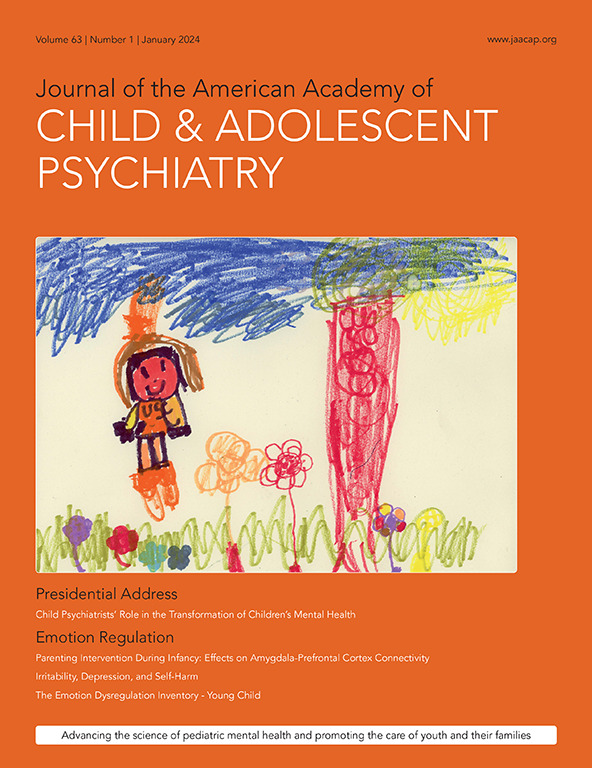A General Factor of Psychopathology Predicts Treatment and Long-Term Outcomes in Children and Adolescents With Obsessive-Compulsive Disorder
IF 9.5
1区 医学
Q1 PEDIATRICS
Journal of the American Academy of Child and Adolescent Psychiatry
Pub Date : 2024-07-01
DOI:10.1016/j.jaac.2024.06.003
引用次数: 0
Abstract
Objective
Children and adolescents with obsessive-compulsive disorder (OCD) are at risk for long-term adversity, but factors influencing long-term outcomes are unclear. A general factor of psychopathology, often referred to as the p factor, captures variance shared by all mental disorders and has predicted long-term outcomes in youth with anxiety and depressive disorders. The p factor has never been examined in relation to outcomes in pediatric OCD. Here, we examine whether the p factor predicts 4 important outcomes over both short and long durations in youth with OCD.
Method
We used data from the Nordic Long-term OCD Treatment Study (NordLOTS), in which youth with OCD (N = 248, mean age = 12.83 years [SD = 2.72], 51.6% girls) received exposure-based cognitive–behavioral therapy. The p factor was estimated using parent-reported Child Behavior Checklist data at baseline and was examined in relation to clinician-rated OCD severity, clinician-rated psychosocial functioning, self-reported depressive symptoms, and self- and parent-reported quality of life directly after treatment and 1, 2, and 3 years after treatment.
Results
The p factor was associated with acute treatment outcomes for OCD severity and psychosocial functioning, but not for depressive symptoms and quality of life. For the long-term outcomes, the p factor was significantly associated with all outcomes except OCD severity. The p factor outperformed traditional psychiatric comorbidity as a predictor of long-term outcomes.
Conclusion
Youth with OCD who experience symptoms across multiple psychiatric domains have poorer long-term outcomes. Compared to traditional classification of psychiatric diagnoses, assessing psychopathology using a dimensional p factor approach may be advantageous for informing prognosis in pediatric OCD.
Plain language summary
Co-occurring mental health symptoms are common among children and adolescents with obsessive-compulsive disorder (OCD). A general factor of psychopathology, called the p factor, can capture broad mental health burden and may be an important predictor of outcomes. Using data from Nordic Long-term OCD Treatment Study, the authors found that the p factor predicted important short- and long-term outcomes, not limited to OCD symptoms, in youth (N=248) with OCD. The p factor outperformed traditional psychiatric comorbidity as a predictor of long-term outcomes.
心理病理学的一般因素可预测儿童和青少年强迫症患者的治疗效果和长期疗效。
目的:患有强迫症(OCD)的儿童和青少年面临长期逆境的风险,但影响长期结果的因素尚不清楚。精神病理学的一个通用因子通常被称为p因子,它能捕捉到所有精神障碍的共同变异,并能预测患有焦虑症和抑郁症的青少年的长期结局。p 因子从未与小儿强迫症的预后相关联。在此,我们研究了 p 因子是否能预测患有强迫症的青少年在短期和长期内的四种重要结果:我们使用了北欧长期强迫症治疗研究(NordLOTS)的数据,在该研究中,患有强迫症的青少年(N=248,年龄:12.83 岁 [SD = 2.72],52.0% 为女孩)接受了基于暴露的认知行为疗法。根据基线时家长报告的《儿童行为检查表》数据估算出p因子,并在治疗后1年、2年和3年对临床医生评定的强迫症严重程度、临床医生评定的心理社会功能、自我报告的抑郁症状以及自我和家长报告的生活质量进行了研究:P因子与强迫症严重程度和社会心理功能的急性治疗结果有关,但与抑郁症状和生活质量无关。在长期疗效方面,除强迫症严重程度外,p因子与所有疗效均有显著相关性。在预测长期结果方面,p因子优于传统的精神病合并症:结论:青少年强迫症患者如果出现多个精神科领域的症状,其长期预后较差。与传统的精神病诊断分类相比,使用维度p因子方法评估精神病理学可能更有利于为小儿强迫症的预后提供信息。
本文章由计算机程序翻译,如有差异,请以英文原文为准。
求助全文
约1分钟内获得全文
求助全文
来源期刊
CiteScore
21.00
自引率
1.50%
发文量
1383
审稿时长
53 days
期刊介绍:
The Journal of the American Academy of Child & Adolescent Psychiatry (JAACAP) is dedicated to advancing the field of child and adolescent psychiatry through the publication of original research and papers of theoretical, scientific, and clinical significance. Our primary focus is on the mental health of children, adolescents, and families.
We welcome unpublished manuscripts that explore various perspectives, ranging from genetic, epidemiological, neurobiological, and psychopathological research, to cognitive, behavioral, psychodynamic, and other psychotherapeutic investigations. We also encourage submissions that delve into parent-child, interpersonal, and family research, as well as clinical and empirical studies conducted in inpatient, outpatient, consultation-liaison, and school-based settings.
In addition to publishing research, we aim to promote the well-being of children and families by featuring scholarly papers on topics such as health policy, legislation, advocacy, culture, society, and service provision in relation to mental health.
At JAACAP, we strive to foster collaboration and dialogue among researchers, clinicians, and policy-makers in order to enhance our understanding and approach to child and adolescent mental health.

 求助内容:
求助内容: 应助结果提醒方式:
应助结果提醒方式:


